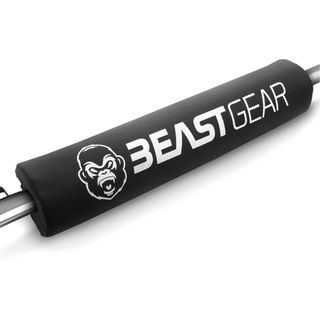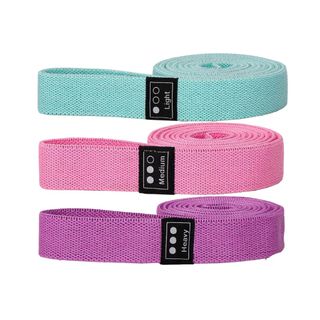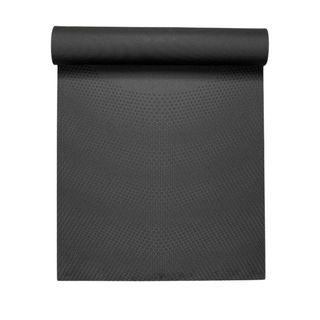Ask any strength and conditioning coach and they’re likely to attest: hip thrusts are the closest thing to a cheat code for glute growth you’ll come across, at least where exercise is concerned. It’s slightly more complex than that, of course – progressive overload (where you gradually increase the challenge level over time) is key when the goal is to build strength and muscle mass, while quality sleep and nutrition are priorities too – as is factoring in any personal limitations. So, just how effective are hip thrusts for glute gains?
“The hip thrust is one of the best exercises for engaging the gluteal muscles,” says Third Space master trainer Lucie Cowan. “These are the muscles in your buttocks, and they consist of three main parts: the gluteus maximus, gluteus medius, and gluteus minimus.”
In short, any of the best glute workouts should include a hip thrust or two. Not totally clear on why glute strength is so important? Well, according to our experts, a myriad of reasons. Not only does it help keep the pelvis and hips stable and facilitate power for propulsion when moving your body (think walking, running, jumping, and so on), but it also reduces your likelihood of injury, particularly to the lower back. In short: don’t skip glute exercises or lower body day.
Keen to introduce hip thrusts into your routine but unsure where to start or how to perform a good quality rep? Below, we've asked Cowan to break down your need-to-knows about the popular move. Wondering, how effective are lunges, how effective are squats, and how effective are planks? We've got expert break-downs of other raved-about compound moves, too. Don't miss what happened when one MC UK staffer tried glute bridges every day or our PT-approved guide to how to grow your glutes, while you're here.
Asking yourself, how effective are hip thrusts? A top expert explains
What is a hip thrust?
A hip thrust is an exercise designed to target and strengthen the muscles in your glutes and hamstrings, Cowan explains. “The movement involves sitting on the floor or against a bench, with your upper back supported and knees bent, and then thrusting your hips upward by squeezing your glutes,” she says. “Many people add a weight, like a barbell or a dumbbell, across the hips to make the exercise more challenging.” Alternatively, you can use resistance bands or just your bodyweight, and some facilities have weight machines designed specifically for hip thrusts."
During a hip thrust, you engage five muscles – or muscle groups. These are:
- Gluteus maximus: “This is the largest muscle in the glutes and the primary one activated during a hip thrust,” Cowan explains. “When you push your hips up and squeeze, this muscle is doing the heavy lifting, making it ideal for strengthening your backside.”
- Gluteus medius and minimus: “These muscles are on the sides of the hips and play a key role in stabilising your pelvis as you move,” Cowan says.
- • Hamstrings: “Located at the back of your thighs, the hamstrings are involved in bending the knees and extending the hips, which makes them essential in the hip thrust movement,” says Cowan.
- Core muscles: Although they primarily target the lower body, hip thrusts also recruit the core muscles. “Your core gets activated to keep your body steady, which can help improve balance and stability,” Cowan goes on.
- Quads: “While the quads (the muscles at the front of your thighs) aren’t the main focus, they also help out a little, especially as you lower your hips back down,” she concludes.
What are the benefits of doing hip thrusts?
Introducing hip thrusts into your training programme can present a variety of benefits – from strength to improved athletic performance.
1. Builds muscle in your glutes
“Hip thrusts are one of the best exercises for targeting the glutes directly,” says Cowan. “They offer a way to isolate and activate the gluteus maximus (the largest muscle in the glutes) more effectively than exercises like squats.” Case in point: one study published in the International Journal of Strength and Conditioning earlier this year explored the effects of barbell hip thrusts on glute growth in untrained women.
The conclusion? That muscle size growth in the gluteus maximus was greater with the addition of the barbell hip thrust, compared to performing exclusively 45º leg press and stiff-leg deadlifts. In short: if altered aesthetics is one of your goals, Cowan confirms that hip thrusts are a go-to move for achieving a “rounder, stronger backside.”
2. Improves lower body strength
Hip thrusts recruit multiple muscles – not just the glutes – so they help you to build lower-body strength. “By regularly strengthening these muscles, you improve your ability to perform everyday movements – like climbing stairs, lifting, or bending – more safely and efficiently,” says Cowan. “Stronger glutes and hamstrings also support other exercises, helping to boost performance in activities like running, jumping, and cycling.”
3. Enhances athletic performance
Strong glutes generate the power needed for propulsion when walking or running, and engaging in other physical activities. “Hip thrusts train the muscles responsible for hip extension, which is crucial in sprinting, jumping, and changing direction quickly,” Cowan explains. “Regular hip thrusts can help athletes or fitness enthusiasts improve speed, power, and explosiveness, making it an effective exercise for anyone who plays sports or enjoys high-intensity activities.”
@hipthrustbelt ♬ AREA CODES X MO BAMBA BY ALTÉGO - ALTÉGO4. Reduces lower back and knee pain
When your glutes are weak, strain is outsourced to other body parts to compensate which can result in injury and pain, particularly in the lower back and knees. “By strengthening the glutes and supporting muscles around the hips, hip thrusts can improve alignment and posture, which reduces compensatory strain on these areas,” says Cowan. “People with lower back pain, especially, often benefit from adding hip thrusts to their routine, as stronger glutes provide better support to the spine and pelvis.”
5. Promotes improved posture and stability
“Strong glutes help stabilise the pelvis and support the spine, which can improve posture and balance,” explains Cowan. Along with the lower body, hip thrusts also activate the core – the muscles which protect the spine. “This stability is crucial and contributes to a more balanced, confident stance, both while standing and during movement,” says Cowan.
6. Helps you advance your squats and deadlifts
“The strength gains from hip thrusts translate well to other strength exercises, particularly squats and deadlifts,” says Cowan. By improving your glute strength with hip thrusts, you’ll find you can lift heavier during other exercises which rely on the posterior chain. “Many strength athletes and bodybuilders use hip thrusts to break through plateaus or to improve their form in squats and deadlifts,” says Cowan.
7. Versatile, accessible and customisable for all levels
What’s especially great about hip thrusts is there’s a variation for all fitness levels. “Beginners can start with bodyweight hip thrusts, and more advanced lifters can add weights, resistance bands, or even try single-leg variations,” says Cowan. Equally, whether you prefer to workout at the gym or at home, hip thrusts can be performed pretty much anywhere – and with or without equipment.
@inshannity ♬ Elevator Music - BohomanWhat is the most effective type of hip thrust?
There are many variations of hip thrusts, and the one which is most suited to you depends on your current circumstances (your fitness and experience level, access to equipment, injury history, and so on) and your goals.
Barbell hip thrusts are often trending on social media, but while they look quite compelling they’re best for intermediate and advanced lifters who want to increase strength and glute size. “This version allows you to load up with heavier weights, making it great for building muscle and strength,” says Cowan. If you want to give them a go, she recommends starting with a light weight and focussing on form before progressively adding more weight.
Another option? Single-leg hip thrusts. “This variation is ideal for those looking to improve glute balance and stability, as it works each side individually,” says Cowan. “Single-leg hip thrusts also engage the core more and require additional stabilisation, so it’s great for intermediate and advanced lifters. These are especially handy to have in your exercise roster when you’re training without access to a variety of equipment and you want to increase the intensity.
Looking for a hip thrust that’s a little more entry-level? Cowan advises trying banded hip thrusts. “These are great for all levels, especially if you’re looking to target the outer glutes and hip stabilisers,” she says. “They’re effective for glute activation and can be used as a warm-up or finisher. For those without access to a barbell, the banded hip thrust can provide a good challenge with minimal equipment.”
How to do a standard bodyweight hip thrust
New to hip thrusts and want to nail the movement before adding weight? Cowan explains exactly how to perform a bodyweight hip thrust:
- Start by setting up your position. Sit on the floor with your back against a sturdy bench or elevated surface (like a couch if you’re at home). The bench should hit just below your shoulder blades when you lean back against it.
- Then, bend your knees, placing your feet flat on the floor hip-width apart, with your heels directly under your knees.
- Next, position your upper body. Lean back slightly and rest your upper back and shoulders on the bench, so your torso is at about a 45-degree angle to the floor.
- When you've done that, place your arms out along the bench to help stabilise your body as you lift, but don’t use them to push yourself up.
- Before lifting, take a deep breath and engage your core by pulling your belly button slightly toward your spine - this will help you maintain stability - and squeeze your glutes and press your heels into the floor.
- Then, lift your hips, pushing through your heels and lifting toward the ceiling until your body forms a straight line from your shoulders to your knees.
- At the top of the movement, your shins should be vertical, and your knees bent at a 90-degree angle. Your torso should be parallel to the floor. Squeeze your glutes tightly at the top, but avoid arching your lower back – keep your core engaged for stability.
- Slowly lower your hips back down to the starting position, letting your glutes hover slightly above the floor (don’t fully relax).
- Repeat the movement for ten to 15 repetitions, focusing on controlled movement and glute activation.
The PERFECT set up for Hip Thrusts/KAS 🔑 - YouTube

What is the most effective rep and set range for hip thrusts?
There’s no one ideal rep and set range for hip thrusts – it really depends on what you’re working towards, and where you’re starting from.
- For beginners looking to build strength and muscle: “perform three sets of 10-12 reps with a moderate weight,” Cowan advises.
- For intermediate lifters wanting to increase strength: “do four sets of eight reps with a heavier weight, aiming for progression each week,” Cowan says.
- For those wanting to improve endurance: “perform two-three sets of 15-20 reps with a lighter weight,” says Cowan.
Shop MC UK approved fit kit now:

Planning on introducing barbell hip thrusts into your programme? A barbell pad will come in handy to reduce any discomfort caused by the bar resting on your hips.

Long Fabric Resistance Bands
Trying hip thrusts for the first time or training on the go? A long loop resistance band – secured either side of your hips – will help to increase the level of challenge.

Designed specifically for training, this 6mm grippy workout mat will make your at-home hip thrusts that little bit more comfortable.




















 English (US) ·
English (US) ·